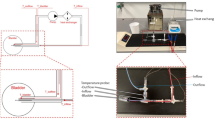Abstract
Local tissue temperature and blood perfusion rate were measured simultaneously to study thermoregulation in the canine prostate during transurethral radio-frequency (RF) thermal therapy. Thermistor bead microprobes measured interstitial temperatures and a thermal clearance method measured the prostatic blood perfusion rate under both normal and hyperthermic conditions. Increase in local tissue temperature induced by the RF heating increased blood perfusion throughout the entirety of most prostates. The onset of the initial increase in blood perfusion was sometimes triggered by a temporal temperature gradient at low tissue temperatures. When tissue temperature was higher than 41°C, however, the magnitude and the spatial gradient of temperature may play significant roles. It was found that the temperature elevation in response to the RF heating was closely coupled with local blood flow. The resulting decrease in or stabilization of tissue temperature suggested that blood flow might act as a negative feedback of tissue temperature in a closed control system. Results from this experiment provide insights into the regulation of local perfusion under hyperthermia. The information is important for accurate predictions of temperature during transurethral RF thermal therapy.








Similar content being viewed by others
References
Baert L, Ameye F, Pike MC, Willemen P, Astrahan MA, Petrovich Z (1992) Transurethral hyperthermia for benign prostatic hyperplasia patients with retention. J Urol 147:1558–1561
Chen C, Xu LX (2002) Tissue temperature oscillations in an isolated pig kidney during surface heating. Ann Biomed Eng 30:1162–1171
Devonec M, Berger N, Fendler JP, Joubert P, Nasser M, Perrin P (1993) Thermoregulation during transurethral microwave thermotherapy: experimental and clinical fundamentals. Eur Urol 23(suppl):63–67
Faber JE (1988) In situ analysis of α-adrenoceptors on arteriolar and venular smooth muscle in rat skeletal muscle microcirculation. Circ Res 62:37–50
Flavahan NA, Vanhoutte PM (1986) Effect of cooling on alpha-1 and alpha-2 adrenergic responses in canine saphenous and femoral veins. Pharm Exp Ther 238:139–147
Homma Y, Aso Y (1993) Transurethral microwave thermotherapy for benign prostatic hyperplasia: a 2-year follow-up study. J Endourol 7(3):261–265
Larson TR, Collins JM (1988) Increase prostatic blood flow in response to microwave thermal treatment: preliminary findings in two patients with benign prostatic hyperplasia. Urology 46(4):584–590
Larson TR, Bostwick DG, Corica A (1996) Temperature-correlated histopathologic changes following microwave thermoablation of obstructive tissue in patients with benign prostatic hyperplasia. Urology 47:463–469
Losev ES (1993) Mathematical simulation of thermoregulation in local hyperthermia. Biofizika 38(5):843–848
Marteinsson VT, Due J (1994) Transurethral microwave thermotherapy for uncomplicated benign prostatic hyperplasia Scand. J Urol Nephrol 28:83–89
Martin GT, Haddad MG, Cravalho EG, Bowman HF (1992) Thermal model for the local microwave hyperthermia treatment of benign prostatic hyperplasia. IEEE Trans Biomed Eng 39:836–844
Mulvin D, Creagh T, Kelly D, Smith J, Quinlan D, Fitzpatrick J (1994) Transurethral microwave thermotherapy versus transurethral catheter therapy for benign prostatic hyperplasia. Eur Urology 26:6–9
Nissenkorn I, Meshorer A (1993) Temperature measurements and histology of the canine prostate during transurethral hyperthermia. J Urol 149:1613–1616
Pennes HH (1948) Analysis of tissue and arterial blood temperatures in resting forearm. J Appl Physiol 1:93–122
Ranade GG, Puniyani RR, Huilgol NG (1995) The response of skin microcirculation to hyperthermic stress in tumor patients. Clin Physiol 15:331–337
Roemer RB, Oleson JR, Cetas TC (1985) Oscillatory temperature response to constant power applied to canine muscle. Am J Physiol 249:R153–R158
Rosette JJMCH, de la Froeling FMJA, Debruyne FMJ (1993) Clinical results with microwave thermotherapy of benign prostatic hyperplasia. Eur Urology 23(suppl 1):68–71
Sapozink MD, Stuart DB, Astrahan MA, Jozsef G, Petrovich Z (1993) Transurethral hyperthermia for benign prostatic hyperplasia: preliminary clinical results. J Urol 143:944–950
Sekins KM, Lehmann JF, Esselman P, Dundore D, Emery AF, de Lateur BJ, Nelp WB (1984) Local muscle blood flow and temperature responses to 915 MHz diathermy as simultaneously measured and numerical predicted. Arch Phys Med Rehabil 65:1–7
Song CW (1984) Effect of local hyperthermia on blood flow and microenvironment: a review. Cancer Res 44(suppl):4721s–4730s
Tharp HS, Zhang W (1993) Analytical study of temperature oscillations in living tissues. IEEE Trans Biomed Eng 40:108–110
Vanhoutte PM (1980) Physical factors of regulation. In: Bohr DF, Somly AP, Sparks HV (eds) Handbook of Physiology, Section 2, Circulation, vol 2, Vascular smooth muscle. American Physiological Society, Bethesda, pp 443–474
Wallenstein S, Zucker CL, Fleiss JL (1980) Some statistical methods useful in circulation research. Circ Res 47(1):1–9
Xu LX, Zhu L, Holmes KR (1998a) Thermoregulation in the canine prostate during transurethral microwave hyperthermia, part I: temperature response. Int J Hyperthermia 14:29–37
Xu L X, Zhu L, Holmes K R (1998b) Thermoregulation in the canine prostate during transurethral microwave hyperthermia, part II: blood flow response. Int J Hyperthermia 14:65–73
Zhu L, Xu LX (1999) Evaluation of the effectiveness of during transurethral radio frequency hyperthermia in the canine prostates: temperature distribution analysis. J Biomech Eng 121:584–590
Zhu L, Lemons DE, Weinbaum S (1995) A new approach for predicting the enhancement in the effective conductivity of perfused muscle tissue due to hyperthermia. Ann Biomed Eng 23:1–12
Acknowledgements
This research was partially supported by NIH 5 R29 CA67970-03. The authors wish to thank Yuanshui Industrial Company for providing the transurethral thermal therapy system and technical assistance to this research.
Author information
Authors and Affiliations
Rights and permissions
About this article
Cite this article
Zhu, L., Pang, L. & Xu, L.X. Simultaneous measurements of local tissue temperature and blood perfusion rate in the canine prostate during radio frequency thermal therapy. Biomech Model Mechanobiol 4, 1–9 (2005). https://doi.org/10.1007/s10237-004-0061-8
Received:
Accepted:
Published:
Issue Date:
DOI: https://doi.org/10.1007/s10237-004-0061-8




